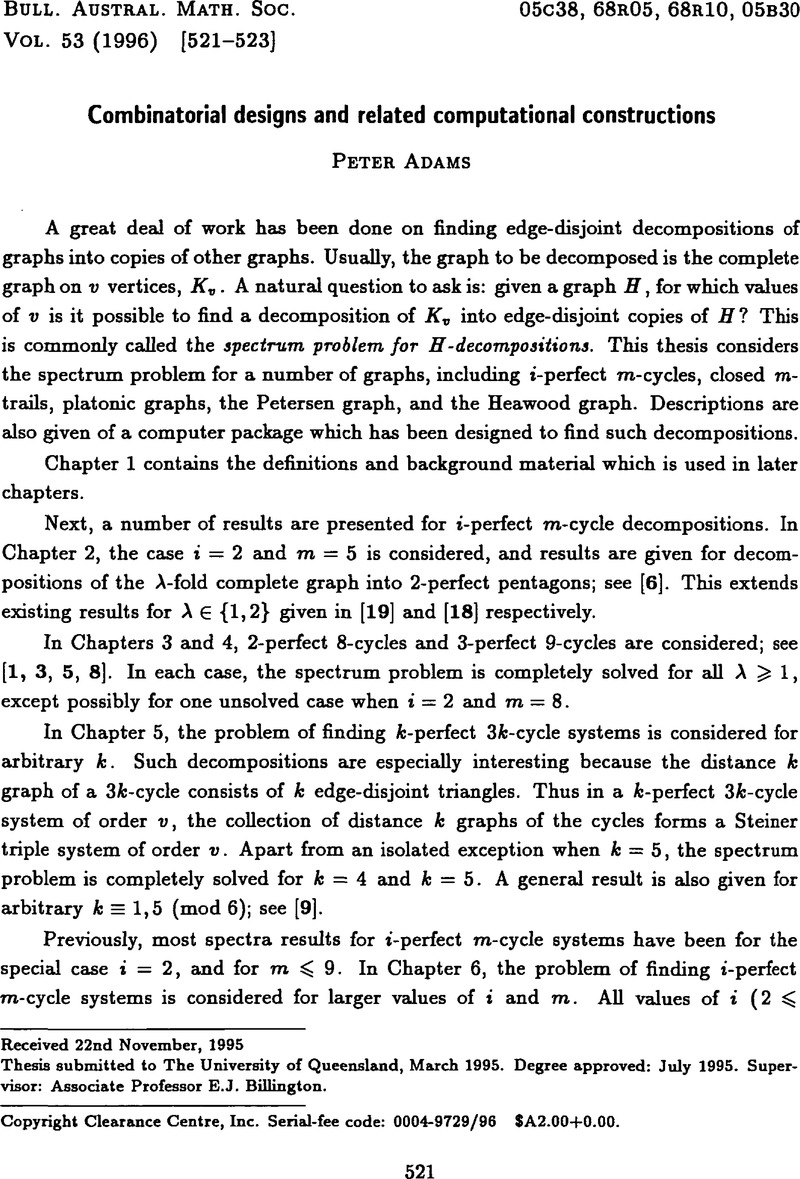No CrossRef data available.
Article contents
Combinatorial designs and related computational constructions
Published online by Cambridge University Press: 17 April 2009
Abstract
An abstract is not available for this content so a preview has been provided. As you have access to this content, a full PDF is available via the ‘Save PDF’ action button.

- Type
- Abstracts of Australasian Ph.D. Theses
- Information
- Copyright
- Copyright © Australian Mathematical Society 1996
References
[1]Adams, P., ‘Lambda-fold 2-perfect 8-cycle systems’, Utilitas Math. 43 (1993), 171–204.Google Scholar
[3]Adams, P. and Billington, E.J., ‘The spectrum for 2-perfect 8-cycle systems’, Ars Combin. 36 (1993), 47–56.Google Scholar
[4]Adams, P. and Billington, E.J., ‘Completing some spectra for 2-perfect cycle systems’, Australas. J. Combin. 7 (1993), 175–187.Google Scholar
[5]Adams, P. and Billington, E.J., ‘Lambda-fold 3-perfect 9-cycle systems’, Ars Combin. (to appear).Google Scholar
[6]Adams, P., Billington, E.J. and Bryant, D.E., ‘Lambda-fold Steiner pentagon systems’, J. Statist. Plann. Inference (to appear).Google Scholar
[7]Adams, P., Billington, E.J. and Bryant, D.E., ‘Partitionable perfect cycle systems with cycle lengths 6 and 8’, Discrete Math, (to appear).Google Scholar
[8]Adams, P., Billington, E.J. and Lindner, C.C., ‘The spectrum for 3-perfect 9-cycle systems’, Australas. J. Combin. 5 (1992), 103–108. Corrigendum: 8 (1993), 277.Google Scholar
[9]Adams, P., Billington, E.J. and Lindner, C.C., ‘k-perfect 3k-cycle systems’, J. Combin. Math. Combin. Comput. 15 (1994), 141–154.Google Scholar
[10]Adams, P., Billington, E.J. and Rodger, C.A., ‘Pasch configurations of lambda-fold triple systems’, J. Combin. Math. Combin. Comput. 15 (1994), 53–63.Google Scholar
[11]Adams, P. and Bryant, D.E., ‘Cyclically generated m-trail systems of order 2m + 1, m ≤ 10’, J. Combin. Math. Combin. Comput. (to appear).Google Scholar
[12]Adams, P. and Bryant, D.E., ‘Decomposing the complete graph into Platonic graphs’, Bull. Inst. Combin. Appl. (to appear).Google Scholar
[14]Adams, P. and Bryant, D.E., ‘The spectrum for Petersen graph decompositions’, J. Graph Theory (to appear).Google Scholar
[15]Adams, P. and Bryant, D.E., ‘Decomposing the complete graph into copies of the Heawood graph’, (submitted).Google Scholar
[16]Adams, P., Bryant, D.E. and El-Zanati, S., ‘Lambda-fold cube decompositions’, Australas. J. Combin. 11 (1995), 197–210.Google Scholar
[17]Billington, E.J. and Lindner, C.C., ‘The spectrum for 2-perfect bowtie systems’, Discrete Math. 135 (1994), 61–68.CrossRefGoogle Scholar
[18]Lindner, C.C. and Rosa, A., ‘Twofold pentagon systems’, Caribbean J. Math. 5, 49–58.Google Scholar
[19]Lindner, C.C. and Stinson, D.R., ‘Steiner pentagon systems’, Discrete Math. 52 (1984), 67–74.CrossRefGoogle Scholar




